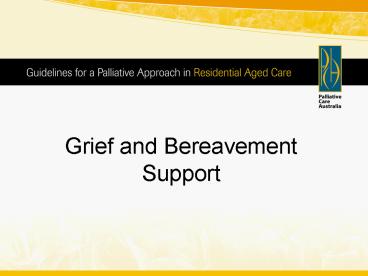Grief and Bereavement Support - PowerPoint PPT Presentation
1 / 26
Title:
Grief and Bereavement Support
Description:
Grief and Bereavement Support Introduction The palliative approach What has been your experience utilising the palliative approach? Aims Provide an understanding of ... – PowerPoint PPT presentation
Number of Views:1997
Avg rating:3.0/5.0
Title: Grief and Bereavement Support
1
Grief and Bereavement Support
2
Introduction
- The palliative approach
- What has been your experience utilising the
palliative approach?
3
Aims
- Provide an understanding of grief, loss and
bereavement as related to the palliative approach
in aged care - Identify situations where there is a risk of
abnormal grief reaction - Identify the support role and needs of the aged
care team - Identify support strategies in grief and
bereavement situations
4
Aims
- Understand the impact of loss and grief on
members of the team as well as the family and
other residents - Identify strategies to implement and apply
support strategies for grief and bereavement
situations - Demonstrate an awareness of the grief reactions
of people from different cultures especially
indigenous Australians
5
Module 1 Defining loss, grief and bereavement
6
Defining loss
- The Guidelines define loss as the severing of an
attachment to someone or something resulting in a
changed relationship
7
Loss can be physical or psychosocial
- Identify examples of physical and/or psychosocial
loss you have experienced - Identify examples of physical and/or psychosocial
loss experienced by residents within your
facility and/or care
8
Defining grief
- The Guidelines define grief as a normal response
to loss. - It includes a range of responses physical,
mental, emotional and spiritual. - These are usually associated with unhappiness,
anger, guilt, pain and longing for the lost
person or thing.
9
Grief
- Grief is
- Experienced in 4 major ways psychologically,
behaviourally, socially and physically - A continuing development
- A natural reaction to loss
- Dependent on the individuals perception of the
loss
10
Defining bereavement
The Guidelines define bereavement as the total
reaction to a loss and includes the process of
healing or recovery from the loss. Bereavement
can be referred to as the state of having
suffered a loss.
11
Reactions
- Our reactions are shaped by a number of factors
including characteristics of - The loss
- The death and
- The bereaved
12
Module 2 Grief reactions
13
Grief reactions
- Normal grief reactions can be defined as a broad
range of feelings and behaviours that are common
after experiencing a loss. - It is not a rigid pattern of feelings or
experiences.
14
Grief reactions
- Grief is experienced differently for each person.
15
Grief reactions
- Grief reactions can be divided into 4 groups
- Feelings
- Physical sensations
- Thought patterns
- Behaviour
16
Characteristics of extreme grief
- intense intrusive thoughts
- pangs of severe emotion
- distressing yearnings feeling incredibly alone
and empty - excessively avoiding tasks reminiscent of the
deceased - unusual sleep disturbances
- maladaptive levels of loss of interest in
personal activities.
17
Module 3 Support needs of the aged care team
18
Support needs of the aged care team
- In your role as carer you will experience loss
and grief and it is important to recognise your
needs and feelings. - How is loss and grief support provided in your
facility?
19
Bereavement planning
- A model for development
20
1. Assess the needs of the aged care team
- Discuss with participants how this could be
achieved within their facility. - Consider the strengths and weaknesses of each
option.
21
2. Develop a strategy to address the needs
- The development of strategies depends on
- current practice and the change required
- intervention required to achieve change
- level of action and impacts anticipated
- the stakeholders involved.
22
3. Develop a plan to implement the strategies
- When developing a plan to implement your
strategy it is important to consider all the
people involved in providing care. - Within your facility identify the groups of
people who should be involved in the
implementation of support strategies.
23
4. Implementing and applying support strategies
- Discuss ways to implement the strategies you
have identified.
24
Module 4 Grief reactions of people from
different cultures
25
Cultural considerations
- Carers and residents come from diverse
backgrounds and bring a variety of cultures,
religions, life experiences, traditions and
expectations to the RACF. - The Guidelines identify 25 of permanent
residents of RACFs as being born overseas
26
Cultural safety
- Cultural safety is practice which respects,
supports and empowers the cultural identity and
wellbeing of an individual, and empowers them to
express that identity and have their cultural
needs met.































